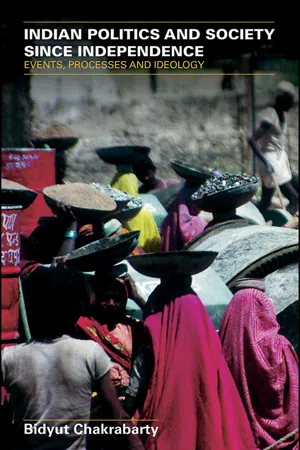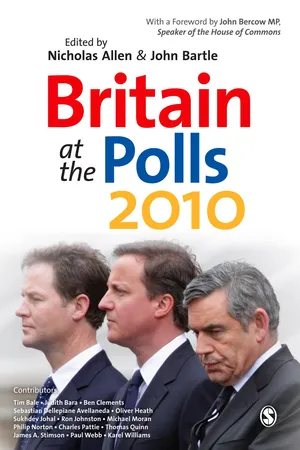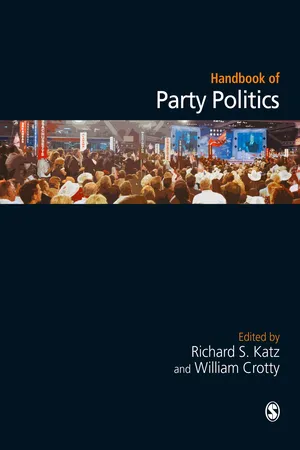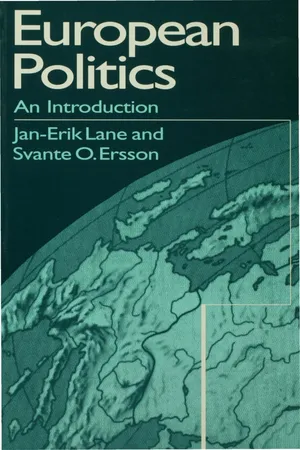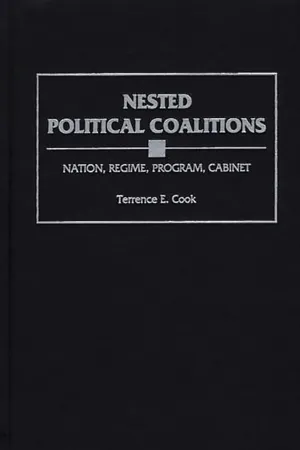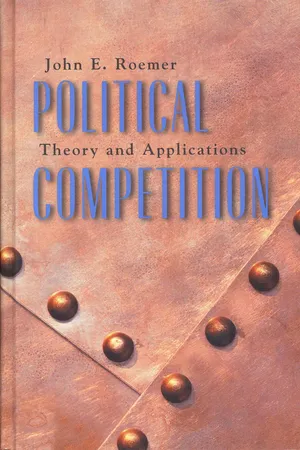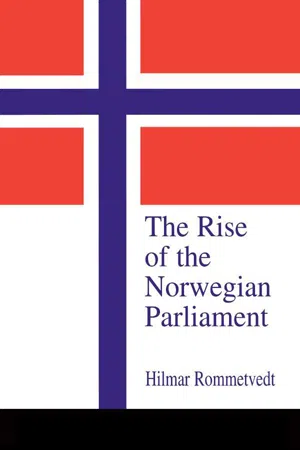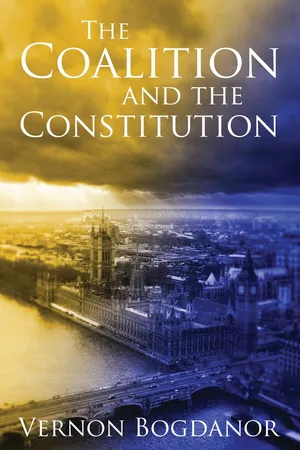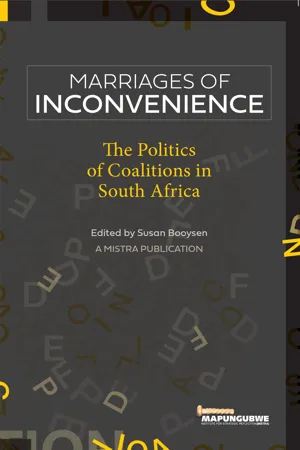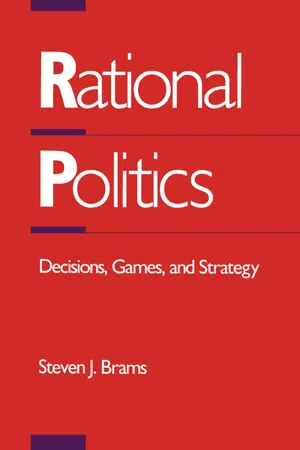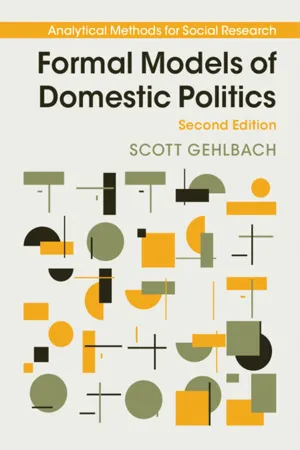Politics & International Relations
Coalition Government
A coalition government is formed when two or more political parties come together to govern a country. This typically occurs when no single party wins a majority in an election. Coalition governments require negotiation and compromise among the participating parties to reach consensus on policies and decision-making. They can bring diverse perspectives to governance but may also face challenges in maintaining unity and stability.
Written by Perlego with AI-assistance
Related key terms
1 of 5
12 Key excerpts on "Coalition Government"
- Yuhlung, Cheithou Charles(Authors)
- 2021(Publication Date)
- Regency Publications(Publisher)
2 Typically, a coalition had been regarded as a parliamentary or political grouping less permanent than a party or faction or an interest group. 3 In This ebook is exclusively for this university only. Cannot be resold/distributed. politics, it signifies a parliamentary or political grouping of different parties, interest groups, or factions formed for making and influencing policy decisions or securing power. In political system, Coalition Government implies the formation of an alliance or temporary union by some groups or political parties in order to exercise control over political power. Coalition Governments are generally formed when no single party is able to command majority in the House. It is also generally accepted that a coalition can take place within the context of mixed motive in which both conflict and common interest are simultaneously present and must govern the course of action chosen. Coalition Government implies the formation of an alliance or temporary union by some groups or political parties in order to exercise control over political power. Thus, a coalition is a phenomenon of a multi-party government where a number of minority parties join hands for running the government, which is otherwise not possible in a democracy based on majority party system. In such situations, various political parties join together to form a government without losing their separate identity. These political parties or groups agree to common minimum political, economic and social programmes, and when differences arise, any party or group is free to withdraw from the coalition. A coalition is thus, an alliance between two or more hitherto separate or even hostile groups or parties formed in order to carry on the government and share the principal offices of the state. Lane and Ersson (1996) classified theories of coalition as policy seeking model and office seeking model.- eBook - ePub
Indian Politics and Society since Independence
Events, Processes and Ideology
- Bidyut Chakrabarty(Author)
- 2008(Publication Date)
- Routledge(Publisher)
7 Coalition politics in IndiaCultural synergy or political expediency?
Coalition building has invariably been an integral part of democratic politics and governance. In its broadest sense, coalition building implies initiation of measures to secure consensus among diverse social groups and communities in the pursuit of a common minimum programme. By this definition, in the competitive environment of democratic society, several agencies including broad mass movements and political parties as well as the governments are constantly involved in building coalitions. When a single political party fails to achieve a clear majority in the legislature, Coalition Government becomes an authentic mode of managing interactions between legislature and executive. In the process, the executive is able to gather staying power on the basis of winning key votes in the legislature. The politics of coalition as well as the functioning of the multi-party Coalition Governments have matured and stabilized in the context of several European countries.1 Coalition seems to have become intrinsic to the Indian polity. This chapter concentrates on its evolution in a historical perspective underlining the critical role of the socio-political processes in shaping its nature. Coalition is not merely the coming together of political parties to capture power; it is also reflective of the fragmentation of social interests at the grassroots. The questions that this chapter thus seeks to address are (a) whether coalition is the culmination of a process that might have begun once the Congress Party ceased to become an umbrella organization and (b) whether coalition is a convenient mode of coagulation of parties, regardless of ideology, for capturing power.Historical roots
The roots of coalition politics in India can be traced back to the nationalist movement and especially in the Gandhian conceptualization of Swaraj. It is true that the non-western leaders involved in the struggle for liberation were deeply influenced by European nationalist ideas. They were also aware of the limitations of these ideas in the non-European socio-economic context due to their alien origin. So while mobilizing the imagined community for an essentially political cause they began, by the beginning of the twentieth century, to speak in a ‘native’ vocabulary. Although they drew upon the ideas of European nationalism they indigenized them substantially by discovering or inventing indigenous equivalents and investing these with additional meanings and nuances. This is probably the reason why Gandhi and his colleagues in the anti-British campaign in India preferred Swadeshito nationalism. Gandhi avoided the language of nationalism primarily because he was aware that the Congress flirtations with nationalist ideas in the first quarter of the twentieth century frightened away not only the Muslims and other minorities but also some of the Hindu lower castes. This seems the most pragmatic idea one could possibly conceive of in a country such as India that was not united in terms of religion, race, culture and common historical memories of oppression and struggle. Underlying this is the reason why Gandhi and his Congress colleagues preferred ‘the relaxed and chaotic plurality of the traditional Indian life to the order and homogeneity of the European nation state [because they realized] that the open, plural and relatively heterogeneous traditional Indian civilization would best unite Indians’.32 - eBook - PDF
- Nicholas Allen, John Bartle, Nicholas Allen, John Bartle(Authors)
- 2010(Publication Date)
- SAGE Publications Ltd(Publisher)
9 THE POLITICS OF COALITION Philip Norton Coalitions in British government – two or more parties combining to form the government of the day – have occasionally been anticipated, sometimes favoured by some political parties, but rarely come to fruition, and when they have it has not been as a consequence of the uncertain outcome of a general election. Coalition Government in one form or another existed in the twentieth century for a period of twenty-one years, but for eighteen of those years the Conservatives could have governed on their own as a majority party. There were also in total twelve years of minority government, only four of those occurring in the period since 1931. The United Kingdom thus has limited experience of minority government at Westminster and no expe-rience of successful post-election bargaining to create a minimal winning coalition (or indeed any coalition). 1 The only attempt at coalition build-ing in recent history was in February 1974 when Edward Heath sought to bring the Liberal party into a minority coalition, but the attempt failed. 2 The only formal deal done between parties, falling well short of coalition, was a short-lived parliamentary pact between 1977 and 1978 involving the Labour government and the Liberals. 3 Otherwise, single-party dominance has been the norm. The political system has been geared to that political reality. Both the administration of government, and of parliament, proceeds essentially on the basis that a single party will be returned to office, usually with an absolute majority. The outcome of the 2010 general election thus created a unique situa-tion in British politics. It induced post-election, and part public, negotia-tions for the creation of a coalition and resulted in a situation in parliament that bore no resemblance to previous parliaments. - eBook - PDF
- Richard S Katz, William J Crotty, Richard S Katz, William J Crotty(Authors)
- 2006(Publication Date)
- SAGE Publications Ltd(Publisher)
In most countries these coalition agreements are widely available to the general public, which expands their utility for scrutinizing government performance by party bodies, as well as by other actors, such as interest groups, the media, and retrospective voters. Coalition cabinets and parties have, in addition, set up a variety of mechanisms and rules to facilitate the smooth implementation of these agree-ments, to solve conflicts over the way they should be interpreted, to formulate an answer to issues not anticipated by or included in the agreement, and to amend these agreements without jeopardizing the coalition’s survival. Recent empirical research (Müller and Strøm, forthcoming) suggests that in most countries coalition agreements are central instruments for coalition policy-making. They also have an important theoretical role in the process of governance once a cabinet has been formed: PARTIES INTO GOVERNMENT: STILL MANY PUZZLES 183 they are vital devices that make Coalition Government possible and help tackle some of the severe and complex bargaining prob-lems and inherent weaknesses of coalitions, such as limited information, non-simultaneity of exchange, cyclical voting, formal ministerial discretion over departmental policy agendas, their implementation and coordination, prob-lems of interdepartmental interdependency, shared competencies, changes in external con-text, etc. (Lupia and Strøm, forthcoming). Hence, from an empirical and theoretical point of view, coalition agreements emerge as one of the main institutions that make collec-tive coalition cabinets viable. Still the practical working of ‘governing by contract’ remains to a large extent a black box. 17 CONCLUSION The formation of a government is a crucial aspect of democratic politics, because it deals with the conquest of power and the possibility of implementing policies that have been democ-ratically endorsed and legitimated by the voters. - eBook - PDF
European Politics
An Introduction
- Jan-Erik Lane, Svante Ersson(Authors)
- 1996(Publication Date)
- SAGE Publications Ltd(Publisher)
Second, in addition to this information about the level of support in Parliament for the government, one would need information about how many players are involved in each govern-ment. Third, one requires data about the length of time that a government is in power, that is, if it is a coalition between two or more players, then how long does the coalition last. Now , coalitions in politics are any short-run or long-run pact involving two or more parties or groups in Parliament. Temporary coalitions typically focus on a specific problem, the resolution of which makes the coalition unneccesary whether it lost or won. Long lasting coalitions often involve cooperation in governments. For how long formal governmental coalitions really last is open to question . Thus, coalitions may be based on loosely connected ties between the parties or there may be formal cooperation defined in terms of some institutional mechanism. Ad hoc coalitions form in Parliament in relation to specific issues where a temporary coalition may be successful in winning a critical roll call. Government coalitions, however, require a firm collaboration between the parties. Typically, there is a joint declaration of a platform of some kind when a Coalition Government is formed as well as a mutually binding commitment among the parties to work for the imple-mentation of the programme of the government. How much agreement there really exists is again open to question . The less long lasting coalitions tend to be in a country the lower the government durability score is. It has been argued that government instability has risen in the last decade, reflecting the increase in voter volatility. Yet, one should not prejudge the question about the length of time a coalition may hold together or a government may last. - eBook - PDF
Nested Political Coalitions
Nation, Regime, Program, Cabinet
- Terrence E. Cook(Author)
- 2001(Publication Date)
- Praeger(Publisher)
In Coalition Governments, especially when the senior partner does not dominate by its size, as already apparent from Chapter 4, the more parties are necessary to form a majority, the more the program must be either entrusted to specific partners or testily negotiated among the partners. Not surprisingly, the duration of governments (if defined as continuity of both prime minister and the party base) declines as the number of parties grows, in one study taking a sharp turn downward to less than a year when at five or more (Blondel 1982, 115). In multiparty Coalition Governments, any dominance of the prime min- ister recedes once ministries are allocated by the proportionality principle among partners, which were often party factions for past Italian Christian Democratic governments, sometimes even factions opposed to the prime minister (Elgie 1995, 177–79). Coalition cabinets of many and roughly equal parties tend to more collegiality in decision making and also expect more equal sharing of cabinet posts, sometimes joined in this by a some- what smaller party that is crucial (cf. Baylis 1989, 62, 89). Whatever the formal role of the coalition leader in ratifying ministerial choices, when these are outside his or her own party or faction, they are really picked by the coalition partners. Sometimes not only the parliamen- tary party but also the extraparliamentary party organization through its executive (especially in Left parties) also cuts into the game of saying just who is in specific ministries of the Coalition Government. Indeed, in some systems such as that in Finland, these nonparliamentarian party officers may even appoint themselves (Nousiainen 1996, 115). Only rarely would a junior coalition party accept a veto of their first preference by the prime minister or by another junior party of the coalition. - eBook - PDF
Political Competition
Theory and Applications
- John E. Roemer, John E ROEMER(Authors)
- 2009(Publication Date)
- Harvard University Press(Publisher)
14 Toward a Model of Coalition Government 14.1 Introduction A Coalition Government forms when there are more than two parties and none of them wins an electoral majority. The underlying situation may be that each party is allotted parliamentary seats in proportion to its vote, and that a majority coalition is required to pass legislation. The literature on Coalition Government, or multiparty politics, is reviewed by Austen-Smith (1996) and Shepsle (1991). We shall not attempt to repeat their work, but shall propose a model of multiparty politics which flows rather naturally from the approach we have developed thus far. In the first part of the chapter we restrict ourselves to the case of a unidimensional policy space, and in the last part, to the multidimensional case. We shall throughout assume that there are three parties. The logic for n parties is the same, although the computations necessary to calculate equilibrium, for even four parties, become fierce. We shall assume, in the first part of the chapter, that parties are of the Wittman variety, maximizing a preference order on policy space. We shall also assume that parties are uncertain about voter behavior, and we adopt the state-space approach to uncertainty. In the latter part of the chapter, when doing multidimensional analysis, we take the view that parties are composed of factions. The natural way of thinking about party competition when there are more than two parties is in a framework with dates (see Austen-Smith and Banks 1988). To wit, there are three dates at which relevant actions occur: Date 0. Each party announces a policy; Date 1. Citizens vote; Date 2. A government forms, and announces its policy. Clearly, for citizens to vote intelligently, they must understand the process by which a government forms and a policy is announced, once the vote is in. 281 - eBook - ePub
The Rise of the Norwegian Parliament
Studies in Norwegian Parliamentary Government
- Hilmar Rommetvedt(Author)
- 2004(Publication Date)
- Routledge(Publisher)
In his memoirs he takes up the relations between the government, the parliamentary party groups and the party organizations in a coalition. With reference to the British politician Leo Amery, Lyng describes this relationship as follows: ‘A government coalition is like a pyramid with a weak foundation. It is tightly connected at the top, i.e. within the cabinet. As one moves downwards from the top to the foundation, the ties become looser’. 37 As Lyng points out, this is explained by the fact that the ministers are a relatively small group of people having almost daily contact with each other. The cabinet members have to act as a unit within the political environment. They have common responsibilities towards parliament. Hence, they develop a sense of common interests and solidarity. The co-operation within the coalition is more complicated on the parliamentary level. The number of politicians involved is larger, and they have less contact with each other. The temptation to operate on their own is greater, due to the competition between MPs and parties. The competition is even keener between the foundations of the parties, i.e. the central and local organizations. Lyng maintains that these organizations take care of the daily contact with voters. They are responsible for attracting voters’ support. Parties that are relatively close to each other, like members of a coalition, are competing for the same voters. What one party gains, another coalition member is likely to lose. Consequently, Lyng says, coalitions are rather short-lived, while parties have a natural proclivity to survive as long as possible. 38 Earlier in this chapter attention was drawn to two sources of disagreement suggested by Andeweg; the ministries and the parties. 39 Lyng points out a third source of disagreement, namely the functional specialization of the various parts of each party. The formation of a Coalition Government implies that the functional differentiation is extended - eBook - PDF
- Vernon Bogdanor(Author)
- 2011(Publication Date)
- Hart Publishing(Publisher)
17 Not only a government but any collegiate executive, whether a Board of Directors or the committee of a students’ union, will make itself look ridicu-lous if it publicly advertises its disagreements. Any such body must therefore weigh up the benefits of employing an agreement to differ rather than trying to discover a compromise formula on which all can unite. It is surely advantageous 14 Hansard HC col 535 (8 February 1932). 15 Hugo Young, The Crossman Affair (Hamish Hamilton and Jonathan Cape, 1976) 84. 16 AJP Taylor, English History (Oxford University Press, 1975 edn (orig 1965)) 321. 17 John Barnes and David Nicholson, The Empire at Bay: The Leo Amery Diaries, 1929–1945 (Hutchinson, 1988) 227. 54 The Coalition and the Constitution if a coalition Cabinet can discover such a compromise formula. For the sanction on any departure from the convention of collective responsibility is not constitu-tional but political. It lies in the danger of public ridicule. 18 III. THE COALITION AND THE CIVIL SERVICE Although the constitutional principles defining the relationship between govern-ment and Parliament may not be altered by the advent of a Coalition Government, there are, nevertheless, considerable differences between the working of a coali-tion government and that of a single-party government. The central difference lies in the reduced power of the Prime Minister in a Coalition Government, and the special position of the Deputy Prime Minister, the leader of the minority party, and of the inter-party Coalition Committee brokering deals on difficult issues. A Coalition Government involves, therefore, considerable modifications to the traditional pattern of Cabinet government. But, as well as modifying the role of the Prime Minister and the Cabinet, a Coalition Government also creates constitutional problems for a neutral, apolitical civil service. - eBook - PDF
Booysen: Marriages of Inconvenience
The politics of coalitions in South Africa
- Susan Booysen(Author)
- 2021(Publication Date)
Nonetheless, these actions and non-actions resulted in compromised governance that severely affected the ‘stability in the City’ (Nyoka, 2020). C O A L I T I O N G O V E R N I N G A N D P O L I T I C A L L E A D E R S H I P The behaviour, decision-making and preferences of political actors (elected representatives) are one of the variables consequential to the efficiency and stability of coalition governing (Chan and Leung, 2007: 171). As Teles (2013: 23, 25) emphasised, political leaders are Marriages of Inconvenience 354 important for good governance, as they need to be responsive, and guide and influence the creation of ‘rival strategies based on citizens’ preferences’. While political coalitions are more complex than merely a function of individual political actors, leading a coalition includes managing intracoalition conflict. Thus, coalition leaders’ roles and personalities influence the initiation, sustainability and termination of alliances (Kadima, 2014: 8). This flags the requirement for both individual and collective political leadership; it is not merely a leader’s attributes that are important, but also the ‘way they perform their role’ (Teles, 2013: 32–34). The political disposition of coalition leaders is critical, particularly how they perceive their roles and one another’s motives, as coalitions are inherently about cooperation and bargaining. In Tshwane, the constantly changing agenda for the Coalition Government, and the jockeying for roles on the mayoral committee, in development projects and for senior appointments, created what Vercesi (2016: 174) posited as the ‘difficulty of formulating final decisions’ in a coalition council. Divergent positions emanate from the preferences of factions, individuals and party leaders. At the individual level, Teles’s (2013: 23) research on the ‘exercise of leadership’ offers a critical reference point, particularly in relation to ‘governing as a way to improve coordination and providing strategic leadership’. - eBook - PDF
Rational Politics
Decisions, Games, and Strategy
- Steven J. Brams(Author)
- 2014(Publication Date)
- Academic Press(Publisher)
Coalitions 8.1 Introduction In almost all political games involving more than two players, the selection of coalition partners—not simply an individual strategy— assumes central importance. This is not true in the two-person games studied previously, wherein calculations of advantage were purely indi-vidualistic. Threat and deception strategies, as well as the strategy of conditional cooperation, did presume communication and coordination between the players, although not for the purpose of putting together coalitions in n-person games (n > 2, that is, the games relevant to the study of coalitions) to accomplish certain ends, such as winning elections. (A coalition, as the term will be used here, is a subset of players in a game.) Yet a large part of politics involves calculations of how other actors might enable a player to win a contest, obtain a preferred outcome, or enhance his or her influence in a particular situation. A coalition's ability to implement a particular outcome is, of course, closely related to its power. By comparison, the power of an individual player is closely related to how crucial he or she is in the formation or maintenance of a coalition, as suggested by the notion of critical defection underlying the Banzhaf voting power index (Section 5.4). This duality raises an interesting question: Is a player powerful because of his or her position in a coalition (for example, by being instrumental in its taking a particular stand), or does a coalition form because players are powerful through their being in it (for example, by their collective ability to enforce an agreement or obtain something of 8 175 176 Rational Politics value)? In politics, it seems, the power of players in a game is inextricably linked with the coalitions of which they are members, and any scheme that attempts to disentangle the players from the coalitions they consti-tute necessarily simplifies reality. - eBook - PDF
- Scott Gehlbach(Author)
- 2021(Publication Date)
- Cambridge University Press(Publisher)
6.3 Government Formation 147 ruling coalition survives to the second period, and the expression on the right is the payoff if the proposal fails and the default allocation is implemented in both periods. Simplifying, we see that legislator 2 accepts any offer such that x 2 ≥ 1 4 . In contrast, legislator 3 accepts any offer such that her payoff x 3 satisfies x 3 + 1 6 ≥ 1 3 + 1 3 , or x 3 ≥ 1 2 . Clearly, it is cheaper to include legislator 2 in the policy coalition— legislator 2 is willing to accept a smaller offer in the first period for the sake of having a chance to be agenda setter in the second. Similarly, if cho- sen to be agenda setter, legislator 2 always chooses legislator 1 to be in her policy coalition. Thus, the policy coalition is always {1, 2} in period 1, whereas the policy coalition is {1, 2} with probability one-half in period 2, as shown earlier. The policy coalition survives across the two periods with probability one-half, which is greater than the probability given by Equa- tion 6.6. Legislative coalitions are more cohesive with a confidence vote than without. 6.3 Government Formation We now consider an alternative model of coalition choice, based on Baron and Diermeier (2001), that represents policy choice in a parliamentary sys- tem. The central idea of the Baron-Diermeier model is that policy is chosen by the government, which is a subset of the parties represented in parliament; bargaining over policy takes place within this proto-coalition. However, any government (and associated policy) must be supported by a majority in parliament. A key assumption is that there are officeholding benefits (e.g., jobs for party members) that can be freely redistributed among members of the government. Thus, in contrast to the model of portfolio allocation of Section 4.5, bargaining over policy is jointly efficient among coalition mem- bers.
Index pages curate the most relevant extracts from our library of academic textbooks. They’ve been created using an in-house natural language model (NLM), each adding context and meaning to key research topics.

